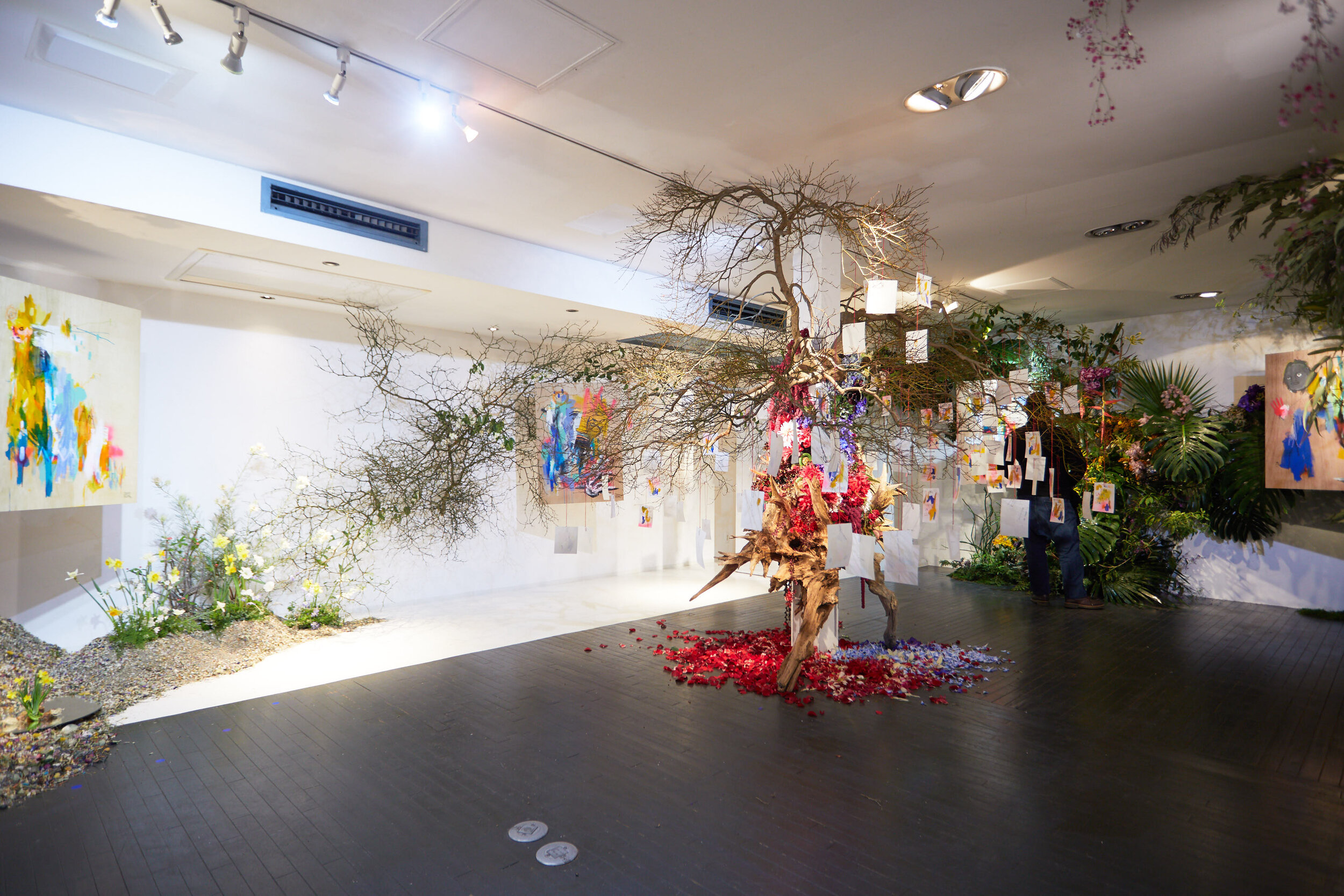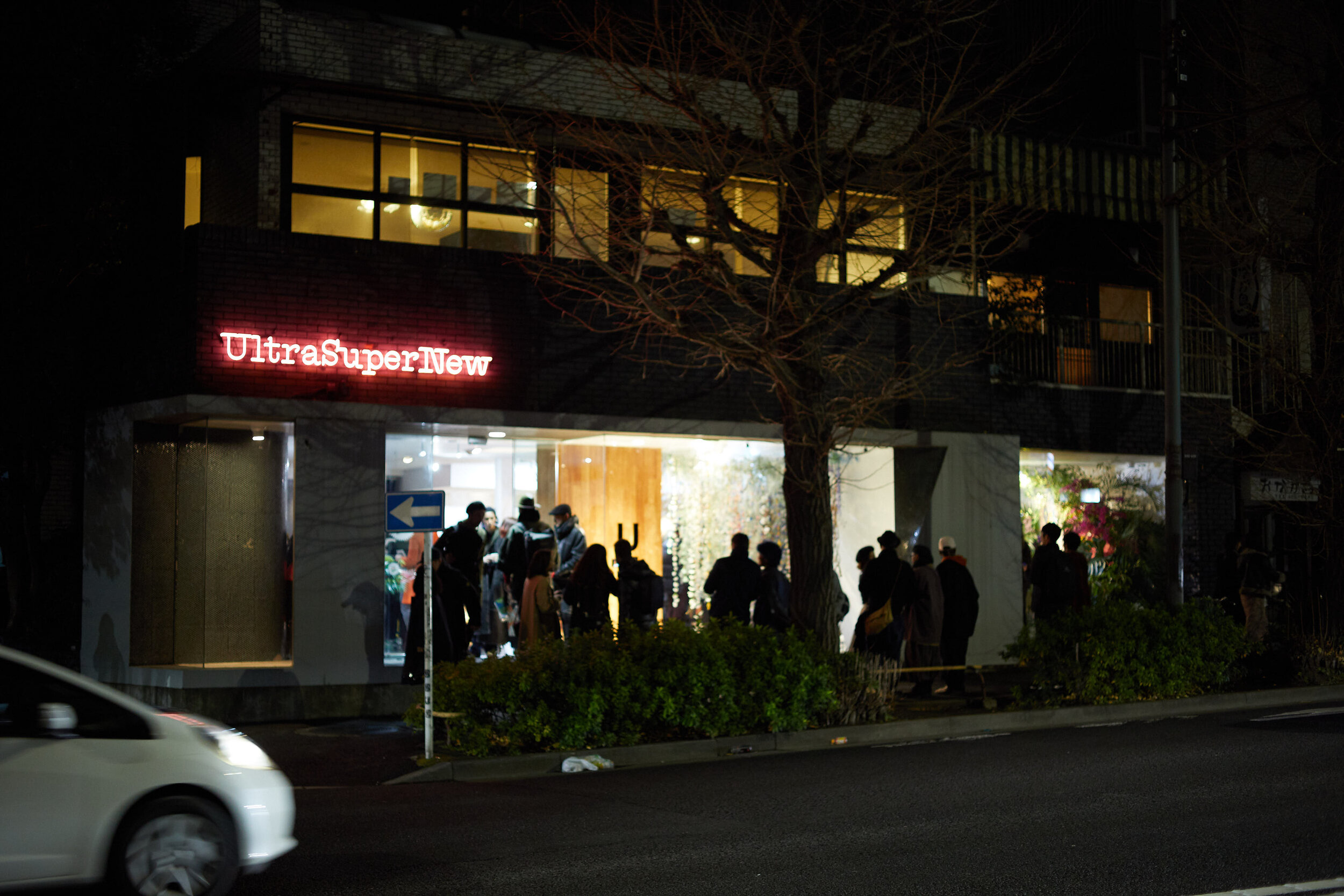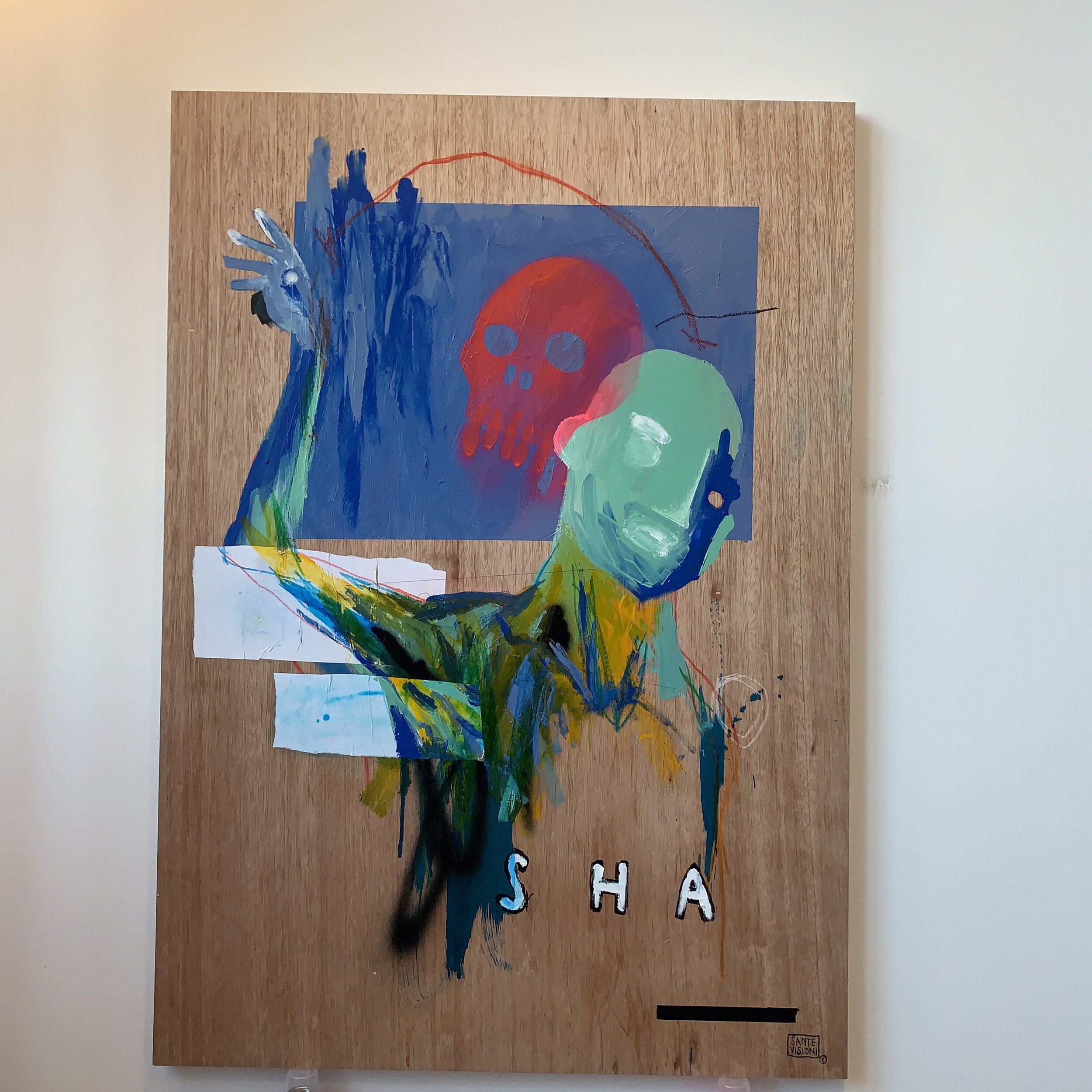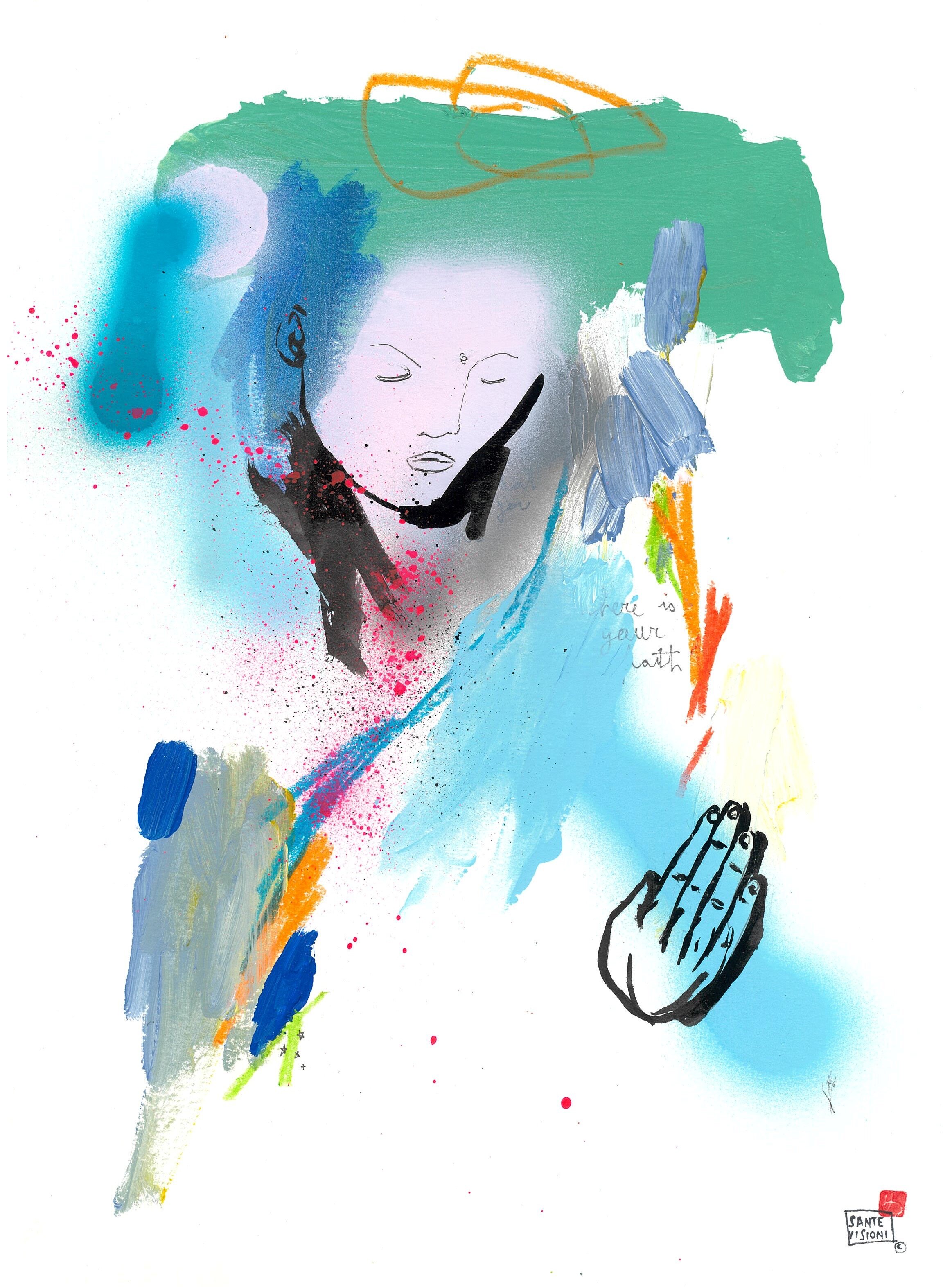Interview with Sante Visioni
Since Sandro Bacchi was a teenager, his paintings were a way for him to express his inner world. Last January, the 33-year-old Italian had his second big exhibition in Tokyo “UZU – Exploring the endless rhythm of life” under his artist name Sante Visioni, in cooperation with flower artist Mitsurin Tokyo – all while still working full-time for Nike.
Sandro Bacchi aka Sante Visioni in front of his artwork at the opening of the Art Start Up 100 collective exhibition in Tokyo
I met Sandro for the first time at Africa Burn near Cape Town last year. And as he says during our interview, “when somebody says ‘I’m a burner’ you already know, that he’s okay in many, many ways”. As for Sandro, his positive, easy-going energy is infectious, he laughs a lot and is always on the search for his next adventure.
Born in Italy, he graduated with a degree in Industrial Engineering in Florence and after his first job in Brazil for a software company, he landed a job in the Nike legal department in Amsterdam. When they offered him a year-long role in Tokyo, he didn’t think twice. Recently, he decided to prolong his stay for another six months to continue his professional as well as artistic work and to keep exploring Japan.
With seven hours’ time difference from Berlin, I reached Sandro in the evening at his apartment in Roppongi. Unbeknownst to me, he was really hungover (as he admits after the interview), but I didn’t notice through our cheerful conversation. We talked about his creative process, having faith along the way and why it’s so important to have something "higher" for which you wake up every morning.
Tell me a little bit about how you grew up and what your childhood was like.
I was born and raised in a very small town next to Florence. So I grew up in a… very simple way, you know. I’m not a city guy, I’m a countryside guy. And growing up in a small city, I experienced quite a closed mentality, you know of the people in general. And let’s say dreaming in a wider meaning of the world was not always easy, because you sounded and looked weird. But with my friends, we always tried to do different things. In a way the Sante Visioni project was born, because in 2010 I joined DPG, the music band of my friends as the painter of the band and during their concerts I started doing live paintings. Until this moment my art was private, then it became public. I saw people reacting to what I was doing in a positive way and that pushed me to do it in a more serious and professional way. That was the moment when I changed my approach to art and I started painting not only for me but also for other people.
Did you also play in the band?
No, we had this concept of music and art together. The band was a mix of punk and electronic music, which nowadays is kind of normal and on top of that there was me painting. We were doing that in 2010 and we were struggling to find places to perform, because for the rock places we were too electronic and for the clubs we were too rock. That’s another example of the mentality where I grew up in.
Is it because of that mentality that you wanted to explore more?
I don’t know, I’m proud of my roots and I think they made me attach importance to many things. I’m very grounded, because I grew up with the simple things, but at the same time, if you asked me, if I would move there, my answer is no, because basically I don’t have anything to talk about with the people living there anymore. Not because I’m superior or whatever, as I said I have respect for my roots and where I come from; it’s always nice to go back, my family is there and also my best friend. But my life now is pretty different. We see things in different ways, we have different mindsets.
Are your parents more open?
My parents are really open, yes. I always travelled a lot with them. My father is very passionate about surfing. In the little town where I grew up he was also kind of a weird one.
How did you come up with the name Sante Visioni?
So when I started these live paintings with the band, during one concert the singer asked me, 'hey, how should I introduce you to the audience?' and I didn’t know and he told me ‚come on, just give me a name‘ and I just said 'Visioni', because I’m just one person and 'Visioni' is plural in Italian, so I liked the contrast of being one with a plural name. Then at the same time a friend of mine was calling me 'Santo' instead of Sandro and I started tagging, in toilets or wherever, 'Visioni', 'Grande Visioni' and at once 'Sante' popped up and I started writing 'Sante Visioni' – and it really stuck with me.
'Sante' also means 'Saint', right?
Yeah, in a way it’s 'Holy Visions', which sounds super religious.
Artwork "Charlot" by Sante Visioni, Tokyo 2019
How does it feel when you’re creating a painting and how does the process look like?
So there are two things, the feelings and what painting in general means to me and then there is the process when I want to create something. So about the feelings, Vale, I mean it’s… maybe it’s pretty obvious, it makes me feel better, it makes me feel alive and it’s a way of throwing out what I’ve inside. When I look at the painting and consider it as finished, it’s like a visualization of what I’m feeling inside. It’s like going to the psychologist, because it’s like talking to myself you know. When I have a problem I visualize it, which doesn’t solve it, but at least I get relieved and the moment I visualize it, it’s like removing a burden from my back. It has always been like that. Also when I’ve been a teenager and I had the typical teenage issues, the friends, the girl that you like all that kind of stuff, drawing was working in the same way for me – it was very helpful.
Then, talking about the process, I always start by listening. Listening to myself or to others. I would say that this part of the process is the more rational. Then I try to make what I received mine. Not many words to describe this phase, it is just a black box driven by the instinct. I just let it go. And the final part is sharing it, making what I envisioned available to all those who want to see it. Connection is what makes me happy. Seeing people reacting to my artworks, engaging with them and feeling them is what closes the cycle.
Do you have to be in a specific mood to start painting?
I don’t have a specific mood, I just go. I’m really thrilled about the blank page. I’m not scared of it at all. I feel attracted to it. My goal in a way is just – and it’s not something I force myself to – is just to enter the flow. And in the moment I’m entering the flow, I feel good, I feel completely connected and alive. And that’s why I feel good after I finished.
So you never have any creative blocks?
Sometimes I take a break. But it’s because I want to take a break, it’s not because I have a block.
Wow, that’s impressive. I feel like it’s so hard for artists or really everyone being creative to always put something out.
Yeah, I never had a block. Sometimes I just don’t want to paint and I stop, and I don’t do anything for one month.
How often do you paint?
Of course it depends a bit on the events that I have. I mean for the exhibition I had to prepare the paintings and I had a deadline and stuff, so I was painting every day. But otherwise, I just take it easy, I don’t know like two, three days per week.
And how long are you painting then?
It depends if I’m in a good mood or not. Sometimes I start and then I don’t like it and I have low energy and then I just say, ‚okay, that’s it‘. But other nights I start and I get into the flow and I stay up until two am.
Tell me about your latest exhibition „UZU“ at UltraSuperNew Gallery in Tokyo?
So the exhibition was a collaboration with the Japanese flower artist Mitsurin Tokyo. Basically it was an experiment for the both of us, because we never did anything like that before. Personally I’ve never seen visual art and plants together.
Yeah, me neither.
But we were both optimistic about it and we started thinking about the concept and in the end it turned out pretty well. The concept of the exhibition is parallelism between the life cycle of humans and plants. Basically this parallelism highlights the differences between these two worlds and in a way invites us to take some inspiration from the plant’s world, because we both think that there are lessons that can be learnt.
Yes, I definitely think we can learn from nature. What would you say is the biggest lesson?
There are many, many lessons. But the biggest lesson and probably the main message we wanted to deliver with the exhibition is the approach to death. Plants are born and they die and they are born again basically – it’s a cycle. And we think that the human life should be seen in the same way, not because of reincarnation or other new age believes, more like accepting the death as a part of life and living your life to learn and from a certain moment on start giving away, meaning tell the new generation about your experiences, share everything that you know and in a way help somebody else with his own life. We think if you go with this approach and if somebody younger than you can live a better life thanks to your advice in a way you are enhancing this cycle of life. Death in the end is just something that happens – but you shouldn’t care so much, you should accept it.
What do you think happens when we die?
Nothing. I’m very nihilistic. The idea of this concept is accepting every moment of your life. If I die tomorrow, it’s okay, you know what I mean. Because you are doing what you are supposed to do now, so it’s also an invite to take control of your life. And then when death comes, it comes, but when you go through this process, you give back, you share what you’ve learnt, you don’t have to be scared at all.
Flower artist Mitsurin Tokyo and artist Sante Visioni at the "UZU" exhibition in Tokyo, 2020
What would you like to share as your biggest lesson you’ve learnt about life so far?
That is a good question. Accepting what happens with a smile and having a positive attitude towards your life I think is in general a lesson I would share, because I think it would help your whole life immediately.
Is that the same message you want to convey with your artworks or do you have another intention as an artist?
It’s an important message to share and it’s definitely something I do in my life, but it’s not the object of my paintings. I mean it can be, but it’s not something I want to deliver necessarily. When I do my paintings, as I said, I want to represent something, usually what I’m feeling in that moment, or how I interpret something. For example for this exhibition the six paintings were about the six different periods of life, from 0 to 15 years old, from 15 to 30, something like that, so I tried to represent each of these phases according to my feelings. The positivity can appear somewhere in some paintings but definitely not in all.
Artwork "Wisdom" by Sante Visioni of "UZU" exhibition in Tokyo, 2020 | © Seki Ryuta
Do you think everyone has a purpose in life?
I think it’s important to define what ‚purpose‘ means, because purpose for me is forever changing. If you have something very defined as a goal, like getting the job or something like that I think it’s kind of dangerous, because in the moment you get it, you don’t have a goal anymore. Don’t get me wrong, of course achievements, goals and challenges must be there, because they push you to your limits, to do always better, but in general I think you should have something ‚higher‘, something far at the horizon that guides you. There is this Japanese word called ‚Ikigai‘ which describes purpose best for me, it means the reason for which you wake up in the morning. This could be something very simple, but you need something to wake up every morning.
If someone asks me, ‚what is your purpose?‘ it’s a very tough question for me to answer by simply declaring a tangible goal „if I get that, my life is achieved“. I don’t think I can say something like that. I want to live my life to the fullest everyday and I have faith that this will make me achieve satisfaction, I have this fire inside that pushes me and I trust it. In the end it probably just matters to be happy, you know. What does it mean to be happy?
I guess art is part of it.
Yeah, it’s a combination. My purpose is not only painting, there are many things that make me happy. In a way painting helps me. It’s really a combination of things that make me feel good, happy and give meaning to my life.
Artwork "A poco a poco tutto insieme" by Sante Visioni, live painting at the bar "PRBAR" in Tokyo, 2019
How did you meet the flower artist Mitsurin Tokyo for you latest collaboration?
I met her here in Japan at my first live painting at a wine festival. She was there as well making a plant installation. We were both drunk, so we started talking and then we discovered that we were both going to Burning Man. So you know the way we looked at each other changed immediately as you know personally Vale…
Yeah, so true, I love that!
Yeah when somebody says ‚I’m a burner‘ you already know, that he’s okay in many, many ways. That’s how we met and then we stayed in touch. And at the Burn last year, we met again, and that’s when I proposed to her to do something together.
Cool. To how many Burns have you been so far?
Three Burning Man plus the Africa Burn plus some other regional ones.
Collaboration Sante Visioni X Shu Uemura, Tokyo, 2019
What was the luckiest thing that ever happened to you?
There are a lot of things, it’s very tough to name one.
Sometimes it’s a person that you met, that taught you something.
Well, when I was in high-school I became friends with the philosophy teacher and I used to go to his house after school with a bottle of wine and basically throw all my teenage problems on him. He was super cool, he was always listening to me and in the end of these alcoholic sessions he used to go to his library, pick a book, write something in it and invite me to read it, because for him it was something to help me with this specific problem we were talking about. He gave me so much good advice, that I still treasure now.
Could you tell me one?
There was one about faith. He told me basically, it’s easy to have a purpose in your life if you know what you want. The metaphor is, it’s easy to walk along a street, even if it’s super long, if you know what’s at the end. The real power is when you walk and you don’t know what’s at the end and if there even is an end. That’s faith. You must have faith in something that you don’t know. For me that was a huge lesson. At that time I didn’t know what I was going to be in the future, I was super confused. And in a way it’s, ‚take it easy and have faith‘. The important thing is, walk, walk, walk and then you will find out what’s at the end.
Is there a favorite book of yours he recommended?
Yes, it’s „Psicomagia“ [„Psychomagic“ in English] by Alejandro Jodorowsky. Do you know it?
No, unfortunately not. I’ll look it up. What are your plans and wishes for the future?
I see Sante Visioni as a project with visual art at the core of course, but it’s more like creating an experience to share with other people. I really want to create something where people enter my world. So these experience events, like that last exhibition, are something that I really want to work on.
Do you have a collaboration in mind, that you would like to do in the future?
I’m very open about that. I think collaborations are always a good idea, especially when there is respect between two artists, or whoever. I think when two different worlds collide the result can be very, very interesting. Now I’ve been asked to do a book cover, it’s a philosophy book that will be released soon in Italy. A friend of a friend recommended me.
Artwork "Liberty" by Sante Visioni, 2019
What’s one thing about Tokyo you didn’t expect?
Loneliness is a social problem here.
The bigger the city, the lonelier the people I guess.
And also because of the culture. In Italy we tend to socialize. You’re sitting next to another person you just start chatting. But here people don’t communicate with each other. They told me that the government makes these events sometimes to make people get to know each other and socialize. It’s like a kids’ playdate organized by the government, think about this, it’s ridicules.
Haha yeah. I think especially Italians are very different. Would you say Tokyo influenced your paintings?
Yes, for sure.
In what way are they different now?
As I said, my paintings are a representation of what I’m feeling. So according to the place where I am, according to how my life is in this specific moment I paint, you know. In the moment I moved to Tokyo I opened a new chapter and I felt full of energy and extremely happy for this opportunity and this challenge and that’s how it reflected in my art. I still paint faces, so that didn’t change, but I see my style evolving, and that is definitely impacted by Tokyo.
I also saw the Face Filter on Instagram from Sante Visioni. That’s super cool. How did this come about?
The Face Filter again was a collaboration. It’s a good friend of mine from Milan, Lewis Lopez, and he does these digital things and he just said, ‚shall we do a filter?‘. So I was doing the painting and he was doing the 3-D modeling to make the filter.
Is there anything else you want to share?
I wanna share, that I just have a good feeling about what this will be in the future. I really have faith something will happen. I can not tell you exactly, but I feel that I’m on the right way. Un bacio.
Discover more from Sante Visioni on Instagram, Facebook , and www.santevisioni.com.













